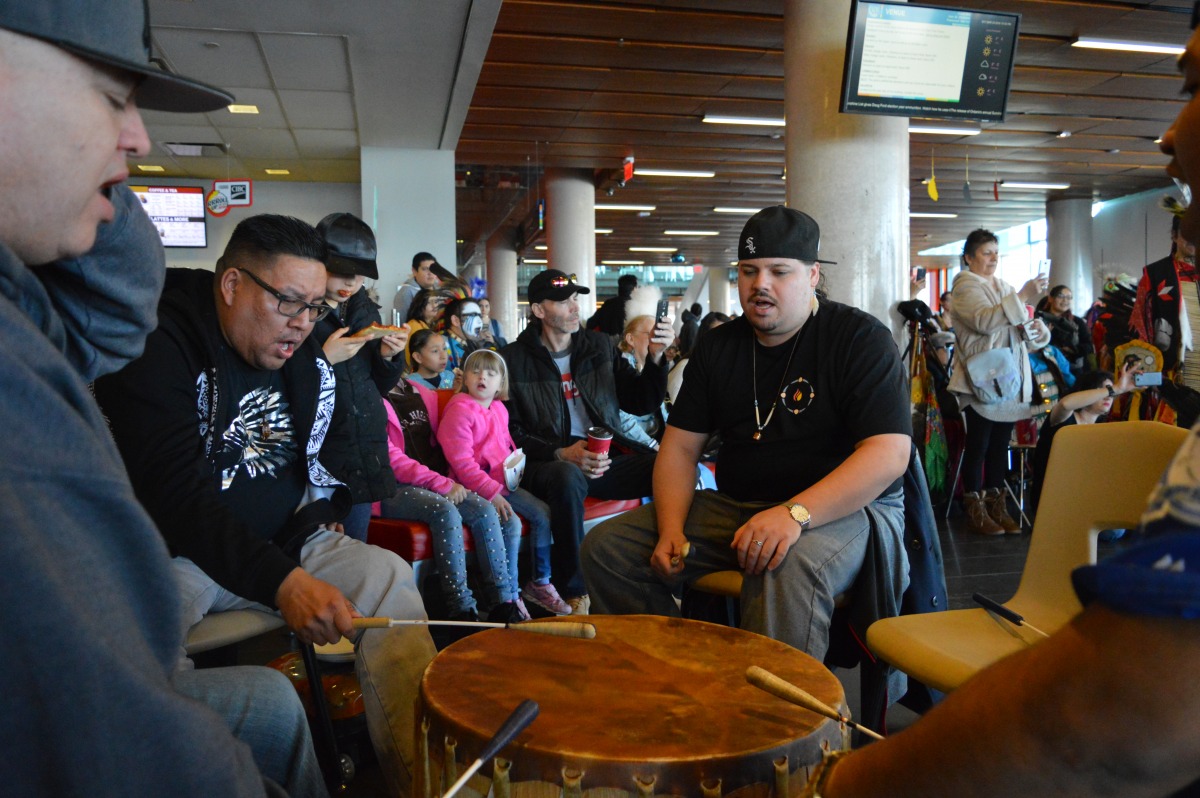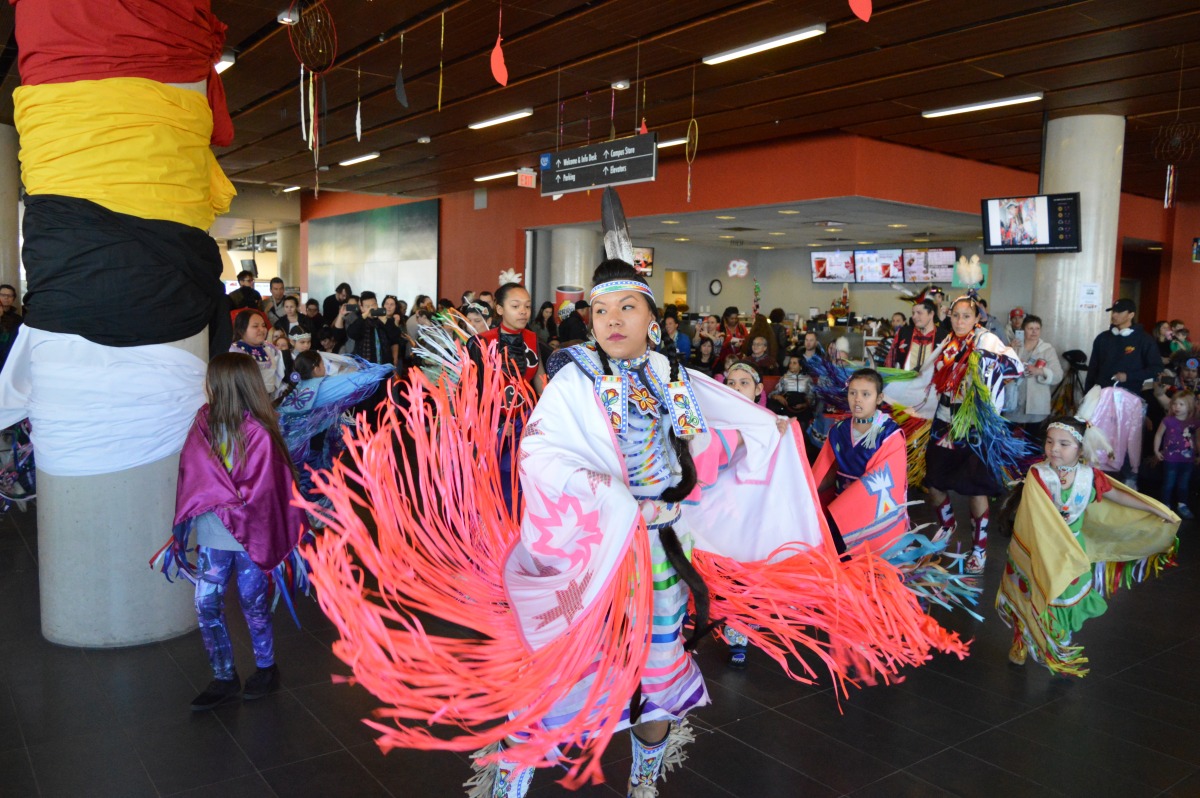The call of the drum brings together current and former students at the Four Sacred Colours Powwow
Red, black, white and yellow paper feathers hang from the ceiling of Waterfront campus. Underneath them, Coty Zachariah sits at a drum wearing a backwards White Sox ball cap.
Zachariah is playing at George Brown College’s (GBC) 10th Annual Four Sacred Colours Powwow with the Young Ogichidaa, or Young Warriors, drummers as dancers in regalia move to the beat.
“It was really important for me to come back to the George Brown powwow,” he says. “Not only (because) it was the tenth anniversary, but it was the first time I really got to be involved in a powwow was during my time as a student.”
Although no longer a student, Zachariah has travelled all the way from Ottawa, where he works as the national chairperson of the Canadian Federation of Students (CFS), to participate in his fifth GBC powwow.

Coty Zachariah, right, plays with The Young Ogichidaa drummers at the 10th Annual Four Sacred Colours Powwow. Photo: Mick Sweetman / The Dialog
Jolene May, who works as support staff for the college’s Indigenous education services, has seen the powwow grow from a small event in the St. James student lounge, into a major cultural event.May, an Ojibwa from Whitefish River Birch Island, grew up on the powwow circuit with her uncle who was a drummer and she has danced in places as far away as Albuquerque, New Mexico.
“It’s amazing to see all the little kids here. It’s important to me because it’s teaching the younger generation their culture and their traditions,” she says holding her seven-month-old son Kaiden. “It’s beautiful to watch them dance and be free and just express themselves.”
For Zachariah, a member of the Mohawks of the Bay of Quinte, the Indigenous community at GBC helped him not only connect with his own identity, it also gave him the confidence to get involved as a student leader.
“As a Mohawk, First Nations student being able to get involved with the Student Association at George Brown, and just organizing around Indigenous events totally empowered me,” says Zachariah who was elected in 2012 as what is now the First Nations, Metis and Inuit representative and served in that role for three terms.
“There were some times where I felt really insecure about my connection to my culture in the past and by the time I graduated from George Brown, I was an Indigenous student leader.”
His activism didn’t stop after graduating from GBC, he went on to university and was elected the Indigenous students commissioner at Trent Central Student Association and later became the chairperson of the CFS’ national Aboriginal caucus.
Pauline Shirt, a Cree from the Red Tail Hawk Clan, has been the wisdom keeper at GBC for the past 10 years and has helped organize the powwow at the college since its start.
“I have seen the little ones come in here with their parents and have their first step,” she says. “That is one of my joys, to see those little ones.”

Women and girls shawl dance at the 10th Annual Four Sacred Colours Powwow. Photo: Mick Sweetman / The Dialog
For Shirt, the real reward isn’t in sitting at the powwow dais, it’s the work she does with students year round. She tells a story about a mature student, who was a little over 50, when he came to GBC.
“Many, many times he wanted to quit,” Shirt says. ”So I always say ‘don’t do that or grandma will kick your…'”
She stops her sentence short laughing at the memory, then says seeing him graduate from college and pursue a masters degree was a highlight of her life.
Shirt says that GBC has built a reputation for not giving up on Indigenous students.
“If they are hungry I feed them,” she says. “There are times when they didn’t have nothing but we share. What we do is we show them how to share with everything.”
Oscar Corbiere, a former social service worker student at GBC, came to the powwow all the way from Manitoulin Island where he now works with Indigenous youth.
He says that being from a small community meant he had trouble making connections in the big city of Toronto when he was a student.
“I was just trying to find my feet and how I was able to ground myself was with the Sahkitcheway room and working with the powwow and meeting people through that,” he says. “It really gave me a grounding that helped me to be able to feel a part of what was going on.”
The college’s senior leadership was also in attendance, sitting respectfully off to the side of the main table where the powwow MC and elders sat overlooking the crowd.
“My most memorable moment at the powwows is to see the dancing and how everyone participates young and old,” says GBC president Anne Sado. “There was a gentleman today on his crutches still going around and participating and it’s that spirit of community that really permeates everything that we do.”

Head female dancer Deanne Hupfield participates in the shawl dance at the 10th Annual Four Sacred Colours Powwow. Photo: Mick Sweetman / The Dialog
While the powwow is a a big deal it’s not the only thing that’s on people’s minds. Canada’s Truth and Reconciliation Commission (TRC) issued 94 calls to action in their seminal report in 2015, including several related to education.
Developing culturally appropriate curricula, including credit courses in Indigenous languages, was one call to action.
As the number of Indigenous students in Ontario continues to rise to almost 10,000, up 25 per cent from 2011 according to a report from Colleges Ontario, the pressure to implement the TRC recommendations is mounting.
Currently GBC offers general education elective courses in Aboriginal studies, Aboriginal education and the early childhood educator program offers an in-class elective option. According to Ian Wigglesworth, the dean for the centre of preparatory and liberal studies, over 600 students took the courses last year.
Growing up in Toronto, Zachariah says he didn’t get much information about his people in school and that having the opportunities to learn about it at GBC opened up a world of knowledge for him.
“It’s almost like I was kind of cheated out of that education, learning about First Nations content,” he says. “But I feel that the rest of Canadians were also cheated out of that experience to learn about First Nations stories, our culture, our clan systems.”
Sado says the college is looking at establishing an Indigenous students centre at Waterfront campus, like the Sahkitcheway and Wi Chi Hito Win centres at St. James and Casa Loma campuses.
For Zachariah, the call of the drum isn’t just what brought him back to the Four Sacred Colours Powwow, it’s also something that helped bring his family together.
“Getting to drum with my father and my nephew at the George Brown Powwow in the past has been a really powerful experience because that was the first time we did that together,” he says.
As Zachariah looks around the powwow he comments on how many children are there and says “I hope my own daughter gets to dance here one day.”

